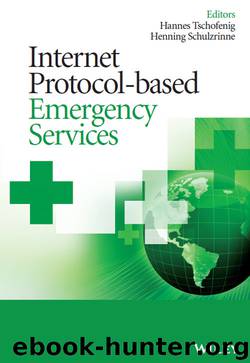Internet Protocol-based Emergency Services by Schulzrinne Henning Tschofenig Hannes & Henning Schulzrinne

Author:Schulzrinne, Henning, Tschofenig, Hannes & Henning Schulzrinne
Language: eng
Format: epub, mobi
ISBN: 9781119993841
Publisher: Wiley
Published: 2013-05-22T16:00:00+00:00
When any of the capabilities required for an IMS emergency call are missing, then the CS domain must be used instead. When both domains are possible based on the registration state, the known UE capabilities and the received indications of network support come into play. For this case it is possible for the operator and the user to pre-configure preferences to influence the decision between the CS and the PS domain.
Limited Service Case
Basically the same limited service cases as in CS domain exist, namely one with a valid (U)SIM and one without a valid (U)SIM. The latter case cannot be authenticated. If there is no roaming agreement between the VPLMN and HPLMN, then even the former case cannot be authenticated.
Additionally to these alternatives, E-UTRAN creates another exceptional case, since the 3GPP Rel-8 and later specifications for EPS specify that E-UTRAN access is only allowed with valid USIM. Thus, a valid subscription with a SIM that allows access to other access technologies of the selected PLMN is not sufficient for normal services in EPS. Emergency calls without a valid subscription are allowed in some countries, and so the system design must also consider this case.
Allowing emergency calls in limited service forces bypassing of security mechanisms. To prevent fraud, usage is restricted to valid emergency cases only.
In GERAN and UTRAN the solution for emergency calls from ME without sufficient credentials was simply to omit authentication and ciphering. In UTRAN, integrity protection is skipped. In E-UTRAN there can be no authentication either, but the handling of this case differs from the GERAN and the UTRAN procedures. After skipping the authentication, the security procedures continue as normal but a null algorithm is used.
If the UE has no security credentials and authentication has been omitted, the algorithms and keys are not available for security mode control. However, security mode control is not skipped; rather, a null algorithm with keys that are generated locally by the EMM entities of both the UE and network is employed. A null algorithm is used for both ciphering and integrity protection. Integrity protection is not specified for GERAN and even ciphering is optional, even though usually supported and activated in live networks when possible. After the establishment of a security context, ciphering and integrity protection are normally mandatory in UTRAN and E-UTRAN. The UE will then require both ciphering and integrity protection, but for the emergency case the UE must accept the null algorithm in SECURITY MODE COMMAND.
If an authentication failure occurs during an emergency attach, then the MME is allowed to make an exception to processing of the failure and allow the emergency attach procedure to continue. Similarly, the EMM entity on the UE side must be prepared for the attach procedure to continue even after the UE has detected an authentication failure. If the network is configured to skip the authentication, then it can respond with a SECURITY MODE COMMAND, which the UE must consider as implicit acceptance of authentication. The command will indicate a null algorithm, since in this case USIM-based security is not available.
Download
Internet Protocol-based Emergency Services by Schulzrinne Henning Tschofenig Hannes & Henning Schulzrinne.mobi
This site does not store any files on its server. We only index and link to content provided by other sites. Please contact the content providers to delete copyright contents if any and email us, we'll remove relevant links or contents immediately.
| Automotive | Engineering |
| Transportation |
Whiskies Galore by Ian Buxton(41879)
Introduction to Aircraft Design (Cambridge Aerospace Series) by John P. Fielding(33064)
Small Unmanned Fixed-wing Aircraft Design by Andrew J. Keane Andras Sobester James P. Scanlan & András Sóbester & James P. Scanlan(32743)
Craft Beer for the Homebrewer by Michael Agnew(18140)
Turbulence by E. J. Noyes(7936)
The Complete Stick Figure Physics Tutorials by Allen Sarah(7307)
Kaplan MCAT General Chemistry Review by Kaplan(6866)
The Thirst by Nesbo Jo(6826)
Bad Blood by John Carreyrou(6552)
Modelling of Convective Heat and Mass Transfer in Rotating Flows by Igor V. Shevchuk(6391)
Learning SQL by Alan Beaulieu(6209)
Weapons of Math Destruction by Cathy O'Neil(6142)
Man-made Catastrophes and Risk Information Concealment by Dmitry Chernov & Didier Sornette(5921)
Digital Minimalism by Cal Newport;(5664)
Life 3.0: Being Human in the Age of Artificial Intelligence by Tegmark Max(5474)
iGen by Jean M. Twenge(5366)
Secrets of Antigravity Propulsion: Tesla, UFOs, and Classified Aerospace Technology by Ph.D. Paul A. Laviolette(5309)
Design of Trajectory Optimization Approach for Space Maneuver Vehicle Skip Entry Problems by Runqi Chai & Al Savvaris & Antonios Tsourdos & Senchun Chai(5011)
Pale Blue Dot by Carl Sagan(4912)
